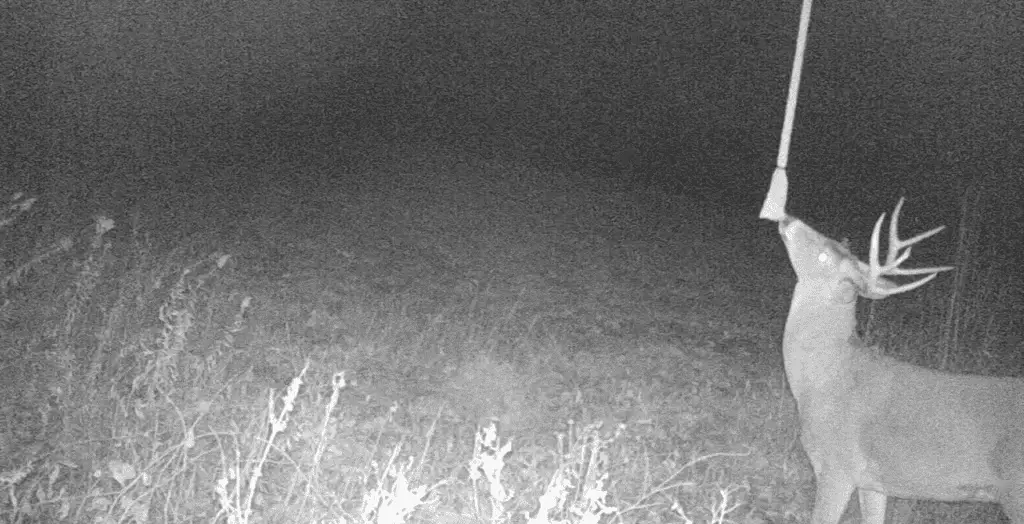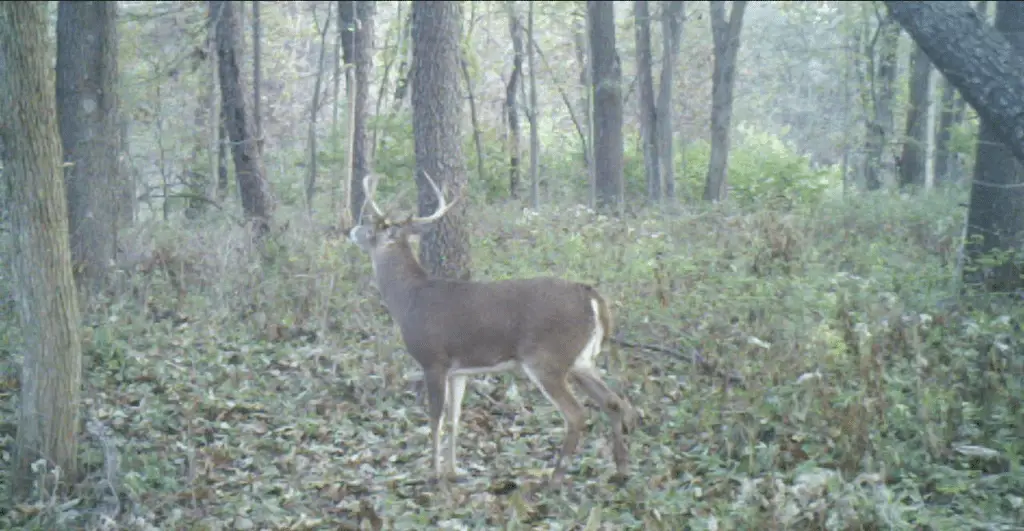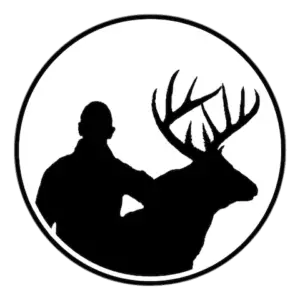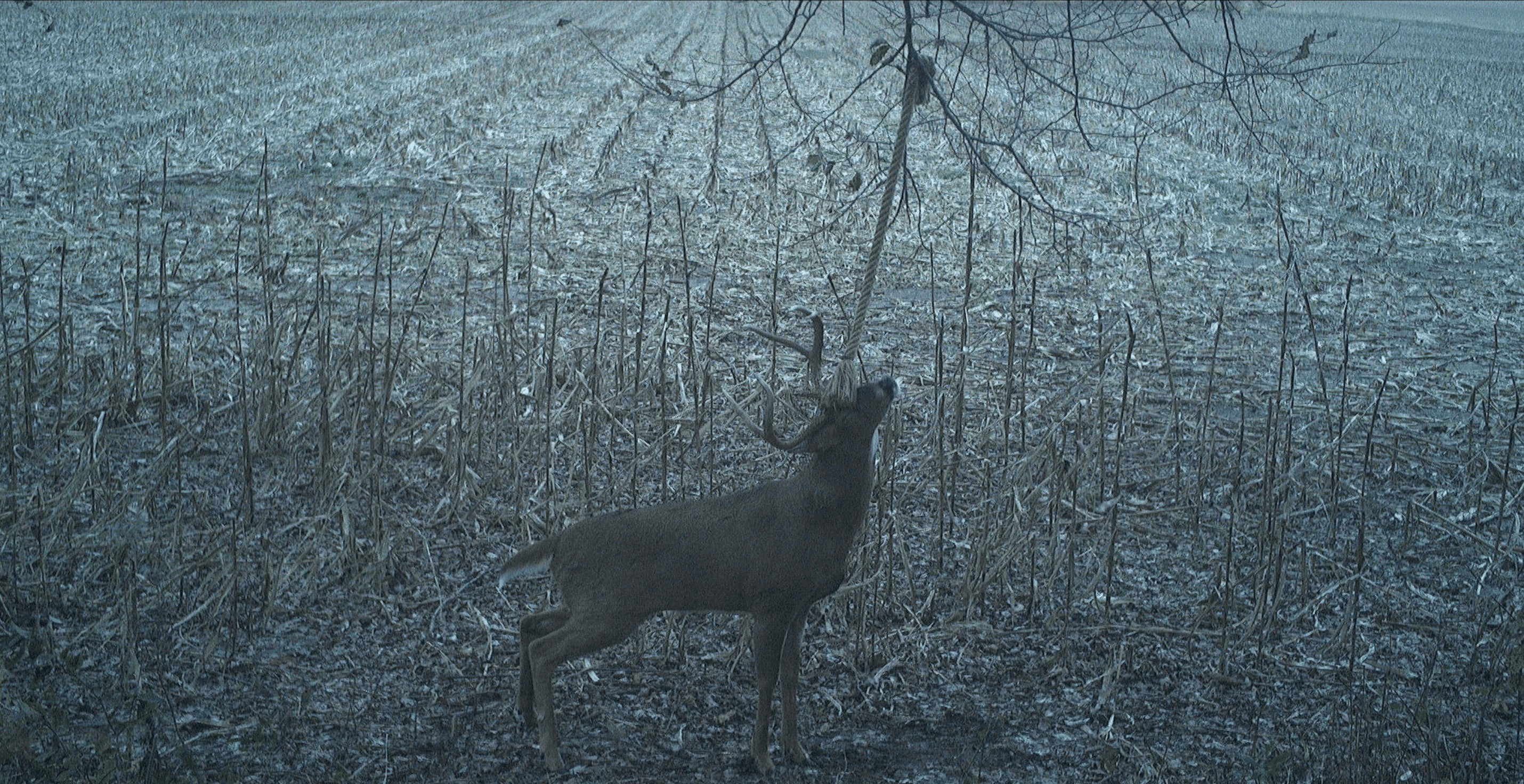Deer hunters have debated about whether or not rope scrapes have the power of attraction that some claim they have. I tested rope scrapes in three different counties in Illinois and have come to one conclusion. They work!
I run many trail cameras and spend countless hours studying trail camera pictures and videos, learning about the deer heard over the course of an entire year. I have a very good idea what’s roaming around on the lands I hunt. Some of my trail cams are overlooking traditional licking branch and vine scrapes and some are monitoring the rope scrapes. I wanted to know for myself what type of scrape that deer used most frequently.
What I have noticed about rope scrapes is that every local deer, does and bucks, used the rope scrapes. I can’t say the same about about a licking branch or vine scrapes even though they had a fair amount of use also. However, to be fair the rope scrapes I set up were located in high traffic area’s where the majority of deer in the area would eventually walk by. I can’t say the same about the other types of scrapes I was monitoring.
Every deer in the woods will use a rope scrape and are extremely comfortable using it.
Why use rope scrapes?
Are you legally allowed to bait deer in your state? I can’t bait deer in Illinois so rope scrapes, water holes, and pinch points are the next best thing for monitoring and taking inventory of the deer herd.
Other than monitoring deer and patterning mature bucks, I have used rope scrapes to bring deer within bowshot of my tree stand. This really works well for getting deer to stop naturally for me to take a shot without having to whistle or bleat at them to stop moving. As long as the wind direction is favorable the deer shouldn’t be alerted at all during the shot which makes for an ideal shooting situation.
I don’t always recommend using a rope scrape at a tree stand location because I typically like to hang rope scrapes where I can easily access a trail camera that’s monitoring the scrape. Some bucks can spook from trail cameras so I typically don’t like the trail cameras too close to my stand and I also don’t want to put any human pressure around my stand from having to check a trail camera.
Where to install a rope scrape?
I typically install rope scrapes in areas that see the most deer activity like on the edge of a field or in a food plot away from my stand location where I can easily check the camera. I don’t care if most of the deer activity at the rope scrape happens at night or during the day. I’m using rope scrapes to learn about which bucks are in the area and the timing of their visit. Bucks will treat a rope scrape like a dog will treat a fire hydrant. They just have to check them out to mark their territory and see who else has been there recently.
Like I mentioned in the previous section I will use rope scrapes at tree stands locations in hopes of getting a buck to naturally come within bow range and stop for a shot.
How to Install a Rope Scrape?

There are several ways to install a rope scrape. The key is that you install them so they last several years without any maintenance. I like projects like this that require a low amount of maintenance!
I have been able to find a tree branch for every rope scrape that I have installed. I attached them to a branch with three of the five methods mentioned in the next section. My method of hanging the rope depends on each specific spot where I’m hanging them. You may have a branch to work with, you may not. You may or may not be able to reach the branch to tie the rope to it. Each rope scrape location can be a little different. I’ve used a ladder and I have used the tailgate of my pickup truck to reach a specific branch. Anyways, here are 5 methods for hanging rope scrapes.
First Method. If you can reach the branch then you can just tie the rope to itself around the branch. This method might not be good for thin branches because it might break over time with the extra weight. Just make a judgment call. This method can require a longer length of rope to get it to the correct height off the ground (3-4′).
Second Method. Use wire to attach the rope to the branch. This is my favorite method. I’ll cut the wire so that there is plenty of slack to make sure I get the rope suspended off the ground at an ideal height (3-4′). I’ll also tie the wire to the branch with a little slack in the knot so that the branch can grow several years without putting stress on the wire.
Third Method. If you have the perfect spot to install a rope scrape but the branch you want to use is too high to reach then this method is for you. Tie a long piece of paracord rope to the hemp rope. The paracode length should be at least twice the height of the branch from the ground. So if your branch is 15 foot off the ground then use 30 foot of paracord. Then use a heavy fishing sinker, or metal nut from a bolt, and attach it to the other end of the paracord. You are going to use the weight to throw it over the branch. Retrieve the weight so you can tie the paracord to itself, suspending the hemp rope at the ideal height off the ground (3-4′).
Fourth Method. You could find two trees and create a line of wire horizontally from tree to tree. Then you can hang your rope from that horizontal wire. Try to tie your horizontal wire at high as you can so deer aren’t accidentally running into it and getting close lined.
Fifth Method. If you don’t have a branch or anything to hang the rope on, then you will have to get creative. I plan on trying this method out in one of my foot plots. First, buy a post to bury in the ground, making sure to get it at least 3-4 feet deep so it holds up for several seasons without falling over. Then attach a tree branch or wooden pole suspending from the post like a flag pole hanging off a house. From there I will hang the hemp rope with a wire from the wooden pole.
How to make rope scrape?

First you need to make sure you have all of the materials that you need. There are a lot of products out there that you can use, but the list below is the supplies I bought and would recommend. Each item has a link to Amazon so you can see exactly what I bought. When I hung my rope scrapes I used three of the five methods mentioned above so I bought everything here, except the ladder because I already owned one. I also ordered enough materials to make many rope scrapes.
Materials you will need:
All materials below have an Amazon link for your convenience. Purchasing these exact products will provide you with enough material to create multiple ropes for various mock scrape locations.
Hemp Rope (1″ in diameter or bigger)
Wire (20 Gauge is recommended)
Rope Cutter (a sharp knife will do the job also)
Heavy weighted Fishing Sinkers (A metal nut from a bolt works too)
Ladder (a climbing stick might also work for you)
- Weed & Grass Killer
Preparing the rope’s for these scrapes is very easy and doesn’t take much time at all. I like to make them in the field so I can make them custom to the spot where I plan to install them.
Once you have all of your supplies the most difficult part of building your rope is learning how to tie the knots. I use what is called a “whipping knot” for tying the paracord and the wire to the hemp rope. Here is a YouTube video demonstrating how to tie a whipping knot. Tying this knot with wire can be difficult if you plan to use wire that is thicker than 20 Gauge. When tying paracord, you will use a lighter to burn off the end of the paracord so it doesn’t unravel over time. This is really easy to do. Just use a lighter to heat up and melt the end of the paracord that you cut.
Lets talk about the business end of the rope that that deer are going to be rubbing their preorbital gland on. I’m going to fray that end of the rope to make it as unraveled and bushy as possible. Before fraying that end of the rope, I will tie a paracord knot about six inches from the end so the hemp rope doesn’t unravel over time. Don’t use wire for this because once you cut the wire it can leave a sharp end sticking out and no deer is going to want to poke their eye on that or have metal rubbing on their face. A hog ring will work but I just don’t prefer metal on the business end of the rope.
Once you have made your rope then its time to install it using one of the five methods mentioned earlier.
Make sure the rope is suspended off the ground about 3-4 feet. This range is critical to putting the rope at the right height for deer to rub their face on. Four feet is ideal for most deer, but fawns probably won’t be able to reach it. If you want fawns to use it then aim for 3 feet. I like 4 feet.
Once you have your rope scrape hanging, there are a few more things you can do to increase the attraction of your rope scrape.
First, work up the ground under the scrape. You can go about this many different ways. I’ve used my own feet to do this and it works fine. A garden rake would work better but is just one extra tool you have to carry with you. The key is that you get the soil worked up and clear all the vegetation, sticks, and leaves below the scrape.
Second, buy some preorbital scent and let the frayed end of the rope absorb that scent. I would recommend scenting your rope if you are installing these close to the start of deer season or during the season. It will help get the deer using them immediately. If you can get your ropes hung several months before the season then I wouldn’t spend money on the scent. I have observed deer hesitate using the rope for the first several weeks after I installed them. That could be because it’s something new that they don’t recognize or they still smell the fresh hemp smell and it’s not familiar to them. They could also just be smelling my human odor still and are spooked by that.
Third, use weed killer to spray the vegetation on the spot where the deer will be scraping. I will also spray down the trails going to and from the scrape with the rope scrape is located within thick wooded cover. Deer like the path of least resistance and spraying your trails will encourage deer to use them. Also, spraying the trails will make your rope scrape more visible as the deer are approaching it.
Conclusion
Rope scrapes simply work. They are well worth the time and money, especially since they will last several years. There is no perfect time to install your mock scrapes but the earlier you can get them installed prior to hunting season the better. I plan to hang several in February and March, which is when I do my scouting for the following year’s hunting strategies.

